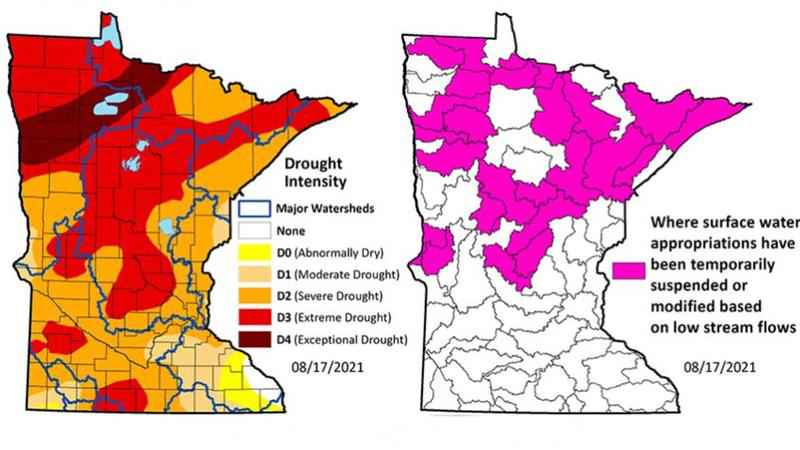71% of Minnesota in severe, extreme drought; restrictive phase activated to protect drinking water supply

[DNR]
As of Wednesday, the state of Minnesota is continuing to see areas with severe, extreme and exceptional drought conditions. The Minnesota Department of Natural Resources announced a drought restrictive phase in response to the conditions for three watersheds to help preserve and protect drinking water supplies.
According to the DNR, 36% of the state is experiencing a severe drought, 35% experiencing an extreme drought and 7% experiencing an exceptional drought as of Wednesday.
The Mississippi River Headwaters, the Rainy River and the Red River watersheds are experiencing extreme to exceptional drought. The DNR will also take the following steps in order to address the drought situation:
- Notify water appropriators with DNR permits that they should minimize non-essential water uses and follow water conservation measures, such as reducing landscape irrigation, using more efficient irrigation equipment, and checking for and repairing water leaks. Water appropriation permit holders can contact the local DNR area hydrologist for technical or with any questions.
- Notify public water suppliers within these watersheds to implement water use reduction actions with a goal of reducing water use to 25% above January levels. Residents, businesses and landowners should watch for communications from their municipal or public water supplier for details on local water use reduction actions and restrictions. Restrictions on non-essential water uses (such as outdoor irrigation, car washes, etc.) may be enacted as public water suppliers take steps to achieve water reduction goals.
- Increasing public awareness or drought conditions.
The entire state entered the drought warning phase in mid-July, according to the DNR. Conditions have worsened in most of the state, particularly northern Minnesota, over the last month. For the first time since the drought intensity classification scale was implemented in 2000, a portion of the state has entered the exceptional drought intensity classification.
The DNR also continues to suspend or modify water appropriations permits for non-priority water users as conditions warrant in specific watersheds. More information about this process, including a map of watersheds where non-priority permits are currently subject to suspension, are available on DNR’s drought management webpage.
Under current conditions, it will take at least five to nine inches or precipitation to spread over a period of about one month to significantly alleviate the drought, the DNR says. Soils are more efficiently replenished by multiple rainfall events than by any single heavy rainfall event. Surface water and groundwater respond somewhat differently over time.
The DNR notes that the current drought is not as severe as the historic droughts of 1988-89 or the 1930s, but it is intensifying, bringing significant challenges to many individuals and businesses and contributing to dangerous wildfire conditions.
"The DNR is implementing the Statewide Drought Plan, which includes significant water use reduction goals for public water suppliers," DNR Ecological and Water Resources Division Director Katie Smith said. "These water use reductions can be difficult but are necessary to ensure water is available for the highest priority uses, such as drinking water."
Minnesotans are encouraged to learn how much water they are using compared to the average American home and identify ways to reduce water use now and in the future. More than 75% of Minnesotans rely on groundwater for their water supply. Reducing use today saves water for the future.
More information on the drought can be found here.
Meanwhile, the Minneapolis Park and Recreation Board announced Thursday it will shut off all decorative fountains for the remainder of the year in response to drought conditions.